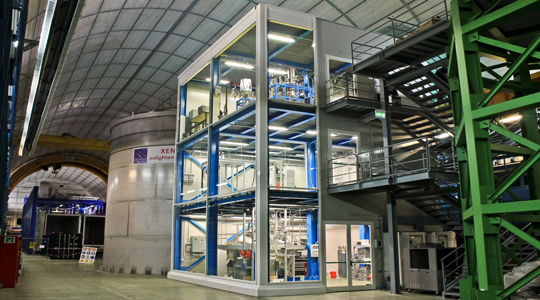 For the first time, new results from the XENON100 international experiment at the Gran Sasso Laboratory of the Italian Institute for Nuclear Physics (INFN) have raised questions about a variety of models previously thought to be a possible explanation for dark matter. The study has been recently published in Science and the XENON100 results are soon to be published in Physical Review Letters. Among the models excluded by XENON100 are some of those developed as an explanation of the signal that was first detected in 1998 and subsequently confirmed at the Gran Sasso Laboratory by the DAMA/ LIBRA (DArk MAtter/Large sodium Iodide Bulk for RAre processes) experiment and interpreted as the signal of particles of dark matter. The signal detected by DAMA/LIBRA, with a seasonal modulation that is consistent with the presence of dark matter, has still not been confirmed by any experiments currently underway. To alleviate the conflict, theorists have postulated that dark matter particles preferentially interact with the electrons, a type of interaction that previous experiments were not sensitive enough to detect. To verify this hypothesis, scientists working on the XENON100 experiment have developed a new method for analysing the data obtained and, for the first time, started looking for dark matter interactions with the electrons of the liquid xenon used as a detector. The new method of analysis should be able to detect a very clear signal of dark matter interactions with the electrons, but none have been detected. On the other hand, the existence of dark matter, as claimed more than ten years ago, is currently the only explanation for the seasonal modulation of the signal observed by DAMA/LIBRA. In view of the results of XENON100, the search will now move beyond the traditional horizon of study in this field. The experiment will therefore continue using a new-generation detector called XENONIT, 20 times bigger and designed to be 100 times more sensitive than XENON100, which will be ready by the end of this year.
For the first time, new results from the XENON100 international experiment at the Gran Sasso Laboratory of the Italian Institute for Nuclear Physics (INFN) have raised questions about a variety of models previously thought to be a possible explanation for dark matter. The study has been recently published in Science and the XENON100 results are soon to be published in Physical Review Letters. Among the models excluded by XENON100 are some of those developed as an explanation of the signal that was first detected in 1998 and subsequently confirmed at the Gran Sasso Laboratory by the DAMA/ LIBRA (DArk MAtter/Large sodium Iodide Bulk for RAre processes) experiment and interpreted as the signal of particles of dark matter. The signal detected by DAMA/LIBRA, with a seasonal modulation that is consistent with the presence of dark matter, has still not been confirmed by any experiments currently underway. To alleviate the conflict, theorists have postulated that dark matter particles preferentially interact with the electrons, a type of interaction that previous experiments were not sensitive enough to detect. To verify this hypothesis, scientists working on the XENON100 experiment have developed a new method for analysing the data obtained and, for the first time, started looking for dark matter interactions with the electrons of the liquid xenon used as a detector. The new method of analysis should be able to detect a very clear signal of dark matter interactions with the electrons, but none have been detected. On the other hand, the existence of dark matter, as claimed more than ten years ago, is currently the only explanation for the seasonal modulation of the signal observed by DAMA/LIBRA. In view of the results of XENON100, the search will now move beyond the traditional horizon of study in this field. The experiment will therefore continue using a new-generation detector called XENONIT, 20 times bigger and designed to be 100 times more sensitive than XENON100, which will be ready by the end of this year.







